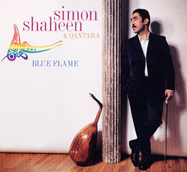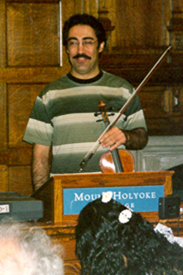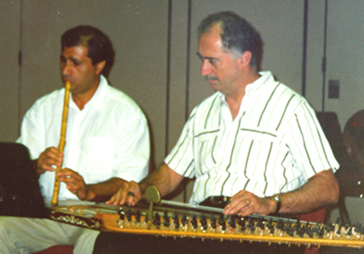|
More
About the Flame: By Sami Asmar Copyright © 1999-2002 Turath.org All rights reserved Asmar: The Blue Flame CD is often promoted as fusion music. What are you trying to fuse and what is your message?
Shaheen: My message is that this is my music. It is based on two facts. First, I grew up playing two instruments, the ‘ud and violin starting at 6 six years old; this is the first duality. Particularly on the violin, I played classical Arabic and Turkish music, classical western music, jazz, and so on, re-tuning the instrument back and forth between the two tuning systems. Second, I grew up listening to recordings of world music. I was in a home environment where American jazz of the fifties and Latin music were often played. This background made it easier to also appreciate Persian and Indian music, for example. When I moved to the US in 1980, I met many fantastic master musicians from all over the world and collaborated with them. I don’t call that experimentation because the products were always final. But what is important about our effort is that we started by establishing the foundation of exposing American audiences to Arab music in its pure form, not the warped form available in nightclubs or through Hollywood. I started the Near East Music Ensemble to emphasize this notion. In the late eighties and earlier nineties, I intensified my collaboration with other musicians such as Indian, jazz, and pop musicians. This is when I started to compose the type of music you hear on Blue Flame. I kept in mind two factors; first that a new genre is coming out and I can contribute to it very well. It is beautiful music that I love, not experimentation but a working genre. Second, most American audiences were still not exposed to quality Arab music or at least not connoisseurs of it. Our new work established a context for them to hear our instrument (ud, nay and violin) like they have not before. In every piece on the CD, the instruments show two faces, we play Middle Eastern style with improvisations and microtones, and then gypsy, jazz, flamenco, or other styles, on the same instrument. No doubt that this will attract more people. There is openness in America towards world music. This is an opportunity to reach a large sector of the mainstream audience. In the final analysis, I can to attract them to also listen to traditional Arabic music in its purest form. Asmar: This is not a collaboration
of brute force. You must have had a formula. Shaheen: What is important about this collaboration concept is the formula. I feel that I found a formula that works organically and naturally. This is not a strange notion of mixing odd things where it does not make sense. The various instruments are interrelated solidly, as far as I am concerned, musically speaking. There is one piece for the ud with a string quartet, for example, and the ud’s sound is truly part of the string quartet, as natural as having a piano with a string quartet. It is very important to bring this as a stand-alone genre that is pure, in my view. Asmar:
Who else has composed fusion with Arabic music and how do you compare you
work to theirs? Shaheen: Many American musicians have tried this. I made a statement in a Rhythm magazine interview a couple of years go, that the so-called fusion music, which started basically in New York, does not make sense to me. Composers did not have the knowledge and background for this diversity to come together. For example, an American musician cannot just learn the nay and then fuse it without having the appropriate background and the tradition in which the nay is played. I am fortunate that I grew up knowing all these traditions and styles, so when I write for the sax in our group, I know the sax upside down and when I write for an American jazz percussionist, I know how to utilize what they know in the context of my composition. I played with numerous instrumentalists until I eventually found the right people who are open minded and know world music very well. Like Jamie Haddad, a jazz percussionist who also knows Indian, Arab, and Latin percussions extremely well. In essence, we composed the rhythm section together. The work is all pre-composed so that when we play ten concerts in a tour, one can hear the same rhythmic section, although there are always variations, just as I do on the ud. Selecting the musicians was key to the success of Qantara. Asmar:
How did you arrive at the group’s name? Shaheen: Qantara means an arch. In Arabian and Andalusian structures, you enter through an arch to see a beautiful court or a lush garden. It is a new world past this arch and Qantara is an entrance to a new world. Asmar:
In terms of your career progression, is this a new phase? Shaheen: It is not new; it is another phase, because none of my works cancels the others. I have not left the classical Arabic style and am planning a new CD of purely traditional ud improvisations and another project with the Near East Ensemble. I have tours planned with that ensemble and with Qantara in parallel. There is also the classical western music; I was commissioned to compose for a string quartet and an orchestra. I don’t want to compartmentalize myself and ignore the other possibilities that I am capable of doing. That would be similar to ignoring the violin, which I am capable of playing for the sake of showing that I play the ud. Asmar:
You composed all the pieces in Blue Flame except two. Tell us about those two? Shaheen: I recorded a composition for the late Turkish composer Cinucen Tanrikorur, which is a samaii, as a tribute to this great composer who was so dear to me. He died last year a week after I visited him. This samaii is so modern yet so traditional. It opens a whole horizon in the art of composing as it was composed very intelligently. I made some technical modifications with the blessings of the composer. The other piece was a rendition or a re-creation of “Tea In The Sahara” by the Police composed by Sting. The plan was for Sting to sing the new version but issues with the label companies have delayed that. Asmar:
speaking of singers, you know that Arabs love vocals.
Do you have any future plans for collaboration with singers? Shaheen: It is a possibility that I will implement only at the right time and with the right singer. Right now my feeling is that it would not be in the Qantara style but more of a classically oriented Arabic style. I want to write a whole complete wasla. This will be my way of opposing the current trends in the Arab world to move away from traditional music. It seems to me that Arab audiences in the Arab world are losing the distinction between pop and traditional music, some go as far considering a given popular singer as the beginning and the end of all Arabic music. This is probably part of a general problem with art and culture the Arab world is experiencing. Asmar:
Where does the music of the Arabs stand now after the passing of the
generation of the great ones? And, how do you see your students spreading the
classical genre? Shaheen: The bombardment of western culture was effective in confusing people in light of the current political, economic, and cultural situation. This is a bad musical period that will pass. It will be a long time but it will pass because we have a solid artistic heritage that will not die. Each of our students is enchanted by the music and can keep the classical genre alive. They are messengers that will influence their community. That is why there is hope. Asmar:
I notice that many people use the word “jazzy” loosely to label
anything out of the ordinary in the context of Arab music (a hint of fusion, a
brass instrument, etc.) and that was probably overused in describing Blue Flame.
How do you feel about that label? Shaheen: I cannot correct a label or an image; I play and let people interpret, just as I do when playing the ud in the Arab world, I don’t allow anybody’s labels to affect my music. The good literature on the CD that I have seen does not state that it is a jazz CD but correctly states that jazz is indeed one of the elements explored in it. I always refer to Arabic music in he context of world music, not strictly one genre. People will catch up with these concepts as long as it is beautiful music. The only question I hope people ask is: “is this beautiful music and does not sound cohesive and organic?” These are the only reason I recorded the CD, beautiful and cohesive, and the fact that I love it! |
Simon Shaheen Discusses Arab Music Education in the US Copyright © 1999-2002 Turath.org All rights reserved
New York-based Arab musician and composer Simon Shaheen has received accolades for his fantastic performances on the ‘ud and violin, earning him an award by the White House. He is also highly interest in music education and fostering classical Arab music in the US via a series of intensive annual retreats. Turath.org caught up with Simon Shaheen at the third annual Arab Music Retreat in August 1999 at Mount Holyoke College in Massachusetts. The set of instructors typically includes Drs. Jihad Racy and George Sawa, as well as members of the Near East Ensmeble such as nay player Bassam Saba. At the third retreat, Glenn Valez taught percussions and Lebanese composer/singer Marcel Khalife taught ‘ud lessons and a chamber music group. One of his compositions, Samaii Hijaz Kar Kurd, was performed by the retreat participants at the conclusion of the week’s activities.
Photos (c) Turath.org The Arabic Music Retreat is a week long intensive course held in mid-August. Directed by Simon Shaheen and Kay Campbell, the retreat focuses on individual lessons on various traditional instruments (e.g., 'ud, nay, qanun, violin, and percussion) as well as voice training. Group lessons included lectures on history, theory, form analysis, and rhythms associated with Arab music. The beautiful setting and the comfortable facilities provided by the campus of Mount Holyoke College help the participants concntrate on learning the music. Simon Shaheen is a master instructor, performer, and composer of Arab music. His records include The Music of Mohamed Abdel Wahab, Saltanah, Taqasim, and Turath. For addirional information on future music retreats as well understanding Mahrajan al-Fann mentioned in the interview, visit Simon Shaheen’s website at: www.simon-shaheen.com
Nay and Qanun instructors, Bassam Saba and George Sawa Asmar: This retreat is pioneering work not even available in Arab countries. What are you hoping to accomplish with it and future projects? Shaheen: The idea is to operate at institutional and national levels. The Retreat, and Mahrajan al-Fann that we produced four times in New York, as well as various educational workshops will eventually lead to establishing the Arab Arts Institute. I am interested in outreach and the education of classical Arab music to Americans and all others. When I first arrived in the US in 1980, there was no understanding let alone respect for Arab music. People only heard it in nightclubs and weddings. After establishing my ensemble, I started lecturing at elementary schools in New York and other major cities on the East Coast, and established assemblies of several classes in the same room. I used the medium of music to throw in information to the children on the geography and history of the Middle East. Things have improved now. Our ensemble performances attract large crowds all over the country. The Mayor of New York attended the last Mahrajan and a reception was held for us at City Hall. This contributed to establishing the Arab community, at the least in the metropolitan New York area, as a legitimate community with a heard voice. We now hope to launch the Arab Arts Institute in the next four years, in a specific physical location, and foster all Arab-American arts. Our work can be a model for other organizations to produce similar retreats elsewhere, especially West Coast. It is true that in the Arab World, classical music is taught only in conservatories. I think the concept of camps or retreats has not caught on in any field, not only music. There is a general tendency to depend on local governments to take the lead and this is such a low priority for any government. Asmar: You keep high standards at the retreat. Do you require participants to be experienced and read music? Shaheen: We intentionally want to keep the retreat small so that students get sufficient individual attention. One way of achieving that is to keep high standards. We do however, encourage beginners and have classes for them. They tend to be enthusiastic and go spread the word. I personally enjoy teaching beginners. I wish I had more time to teach children than I do now. Asmar: What motivated Marcel Khalife to join the faculty this year and is he enjoying it despite the language limitations? Shaheen: Marcel is having a great time and is communicating through music without missing a beat. He is, in fact, one of the few people I know in the Middle East who understands the concept and value of a music retreat. He made the effort and commitment to travel here because he believes in the idea. I only had to ask him once. He can perform for a sold-out theatre and turn around and perform for a child on a street corner.
|


